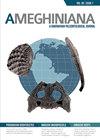A New Erythrosuchid Archosauriform from the Middle Triassic Yerrapalli Formation of South-Central India
IF 1.5
4区 地球科学
Q3 PALEONTOLOGY
引用次数: 8
Abstract
Abstract. Erythrosuchid archosauriforms are quadrupedal carnivorous reptiles with a proportionally huge skull. They represent one of the first evolutionary radiations of medium to large predatory diapsids after the Permo–Triassic mass extinction. Erythrosuchids are known from Lower–Middle Triassic rocks of South Africa, Russia, and China, and there have been preliminary reports from the Middle Triassic Yerrapalli Formation of south-central India. Here we describe, compare and figure for the first time these Indian erythrosuchid remains. We erect the new genus and species Bharitalasuchus tapani based on a holotype and paratype that preserve tooth-bearing cranial fragments, at least 17 presacral vertebrae, some ribs and probable intercentra, and partial shoulder and pelvic girdles and hindlimb and allow recognizing a series of autapomorphies and unique combination of character states among erythrosuchids. Our phylogenetic analysis recovered Bharitalasuchus tapani most closely related to Shansisuchus shansisuchus and Chalishevia cothurnata from the late Anisian of China and Ladinian of Russia, respectively. The phylogenetic affinities of this new taxon and a revision of the tetrapod assemblage of the Yerrapalli Formation shed light on the age of this unit. The presence of the Wadiasaurus-Rechnisaurus-Bharitalasuchus association in the Yerrapalli Formation closely resembles the Sinokannemeyeria-Shansisuchus dicynodont-erythrosuchid association of late Anisian to early Ladinian Chinese units. This evidence supports a post-early–middle Anisian age, even possibly early Ladinian, for the Yerrapalli Formation. The presence of possibly one of the last erythrosuchids in India would indicate that the clade still retained both a northern and southern Pangean distribution before its extinction.印度中南部中三叠世Yerrapalli组中一种新的红类始龙目
摘要红足类始祖龙是四足食肉爬行动物,有着巨大的头骨。它们代表了二叠纪-三叠纪大灭绝后中型到大型掠食性双孔虫的第一次进化辐射之一。在南非、俄罗斯和中国的中下三叠统岩石中发现了红足类,在印度中南部的中三叠统Yerrapalli组也有初步报道。在这里,我们首次描述、比较和描绘了这些印度红子科的遗骸。我们在完整型和准型的基础上建立了新属和新种,这些准型保留了含齿的颅骨碎片、至少17个骶前椎骨、一些肋骨和可能的椎间、部分肩带和骨盆带和后肢,并允许在红尾龙中认识到一系列的自形性和独特的特征状态组合。我们的系统发育分析分别从中国的晚安尼索目和俄罗斯的Ladinian目中恢复了与Shansisuchus Shansisuchus Shansisuchus和Chalishevia cothurnata亲缘关系最近的印度巴利塔苏chus tapani。这个新分类单元的系统发育亲缘关系和对耶拉帕里组四足动物组合的修正,揭示了这个单位的年龄。Yerrapalli组中Wadiasaurus-Rechnisaurus-Bharitalasuchus组合的存在与中国晚安尼西亚至早拉旦期的Sinokannemeyeria-Shansisuchus dicynodont-erythrosuchid组合非常相似。这一证据支持Yerrapalli组存在于中晚期的安尼西亚时代,甚至可能是拉丁纪早期。在印度发现的可能是最后的红子科之一,这表明该分支在灭绝之前仍然保留了盘古大陆北部和南部的分布。
本文章由计算机程序翻译,如有差异,请以英文原文为准。
求助全文
约1分钟内获得全文
求助全文
来源期刊

Ameghiniana
地学-古生物学
CiteScore
2.50
自引率
10.00%
发文量
21
期刊介绍:
Ameghiniana is a bimonthly journal that publishes original contributions on all disciplines related to paleontology, with a special focus on the paleontology of Gondwana and the biotic history of the southern hemisphere. Published yearly since 1957, it has undoubtedly become the main palaeontological publication from Latin America. Ameghiniana has recently broadened its editorial board, reorganized its production process, and increased to a bimonthly frequency, which resulted in a significant decrease in the turn around time.
 求助内容:
求助内容: 应助结果提醒方式:
应助结果提醒方式:


